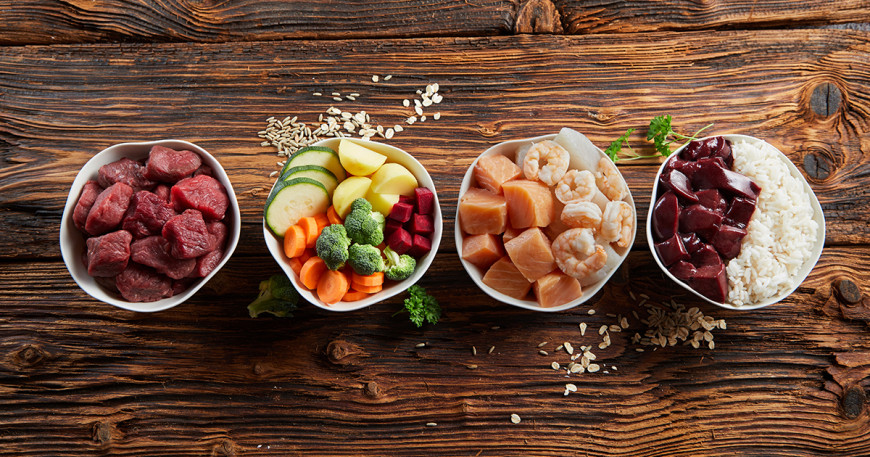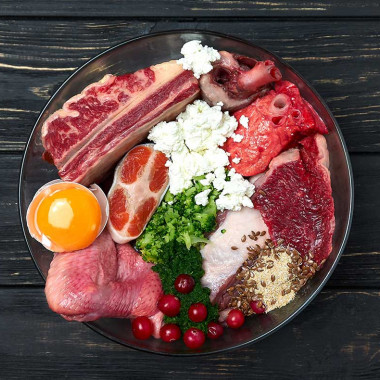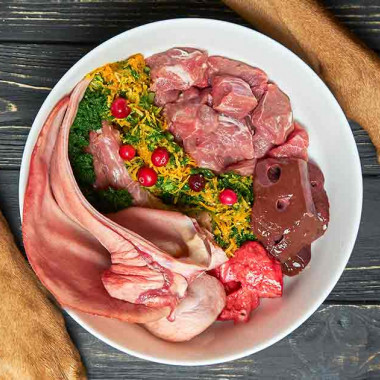If you've decided to get a four-legged companion and want to feed them using the BARF diet but don’t know how to start, this article will help guide you. We will show you how to start feeding a 2-month-old puppy, which is the right time to bring them home. We'll use a feeding plan for a 3 kg puppy at 2 months of age and provide a specific example of a meal plan.
A 2-Month-Old Puppy
We used a 3 kg puppy as an example. Not every puppy weighs 3 kg at 2 months. Some miniature breeds don’t reach this weight even in adulthood, while puppies of giant breeds may weigh as much as 6 kg at this age. You should always focus on the overall condition and health of the puppies. They should be playful, curious, gaining weight appropriately, and not too thin or overweight.
Puppy Feeding Amount
The feeding amount for puppies should be 4-6% of their optimal weight. You don’t need to strictly adhere to these numbers. As you observe whether your puppy is gaining or losing weight too quickly, you can adjust the amount of food accordingly. To make calculations easier, we’ll use an average of 5%. So if we have a 3 kg puppy, the total amount of food per day will be 150 g. As the puppy grows, it’s important to adjust the amount of food to match their current weight to ensure proper growth.
Calculation: 3 (puppy weight in kg) x (5 (%):100) = 0.15 kg = 150 g
Simplified: 3 x 0.05 = 0.15 kg
Composition of the Feeding Plan
The 150 g of food for the puppy should consist of 50% meat (40% muscle + 10% offal), 30% bones, and 20% supplements. Compared to adult dogs, puppies need more bones to cover their calcium needs for bone growth, teething, and overall development.
Calculation:
Muscle meat: 150 (g of food) x (40 (% muscle):100) = 60 g
Offal: 150 (g of food) x (10 (% offal):100) = 15 g
Bones: 150 (g of food) x (30 (% bones):100) = 45 g
Supplements: 150 (g of food) x (20 (% supplements):100) = 30 g
Supplements consist of vegetables, fruits, and grains. The ratio should be 60% vegetables, 30% fruit, and 10% grains. If you choose not to include grains, the ratio is 70% vegetables and 30% fruit.
Calculation:
30 (g supplements) x (60 (% vegetables):100) = 18 g vegetables
30 (g supplements) x (30 (% fruit):100) = 9 g fruit
30 (g supplements) x (10 (% grains):100) = 3 g grains
You don’t need to follow the amounts down to the exact gram. Once you have calculated the feeding plan, divide it into 5 portions. It’s better to feed a 2-month-old puppy small portions more frequently, ideally 5 times a day. So divide the 150 g daily portion into approximately 30 g servings.
Transitioning to BARF
If your puppy was already fed BARF by the breeder, it will be easier for both you and the puppy. You simply continue feeding as they are used to. If the puppy was fed kibble, it’s better to wait before transitioning to BARF. The change in environment, new people, smells, and sounds are stressful enough for such a small creature. Therefore, it’s better to feed the puppy what it’s used to for at least the first two weeks. The transition to BARF can be done overnight.
What to Put in the Puppy’s Bowl
To start, you can offer easily digestible meats such as chicken, veal, lamb, turkey, or rabbit. It’s best to feed only one type of meat per day. If you start with chicken and notice redness around the groin, eyes, ears, diarrhea, vomiting, or excessive scratching (with no parasites), your puppy might be allergic to chicken. Try turkey, lamb, or veal instead. Suitable offal includes poultry hearts, stomachs, and unwashed beef tripe. You can use chicken wings, carcasses, and necks, and later other types of bones. Suitable supplements are vegetables (except legumes, cauliflower, cabbage), fruits, rice, buckwheat, millet, and oats. You can also add dairy products or eggs.
A Tip for Starting
Until the puppy gets used to eating large chunks of meat and bones, it’s better to grind or crush them into smaller pieces. The meat can also be lightly cooked to make it more appealing and digestible, but never cook or bake bones—only raw, meaty bones should be fed. To save time, you can buy ground meat or meat with cartilage from our shop. Vegetables should be grated, ground, blanched, or frozen.
Once your puppy has adjusted to raw food, you can gradually introduce all types of meat, vegetables, fruits, dairy, whole bones, and fish. Later, you can include supplements such as yeast, seaweed, joint supplements, and various oils rich in omega-3 and omega-6 essential fatty acids. The more varied the diet, the better for your dog.
Sample Recipe to Start
Based on the calculations above, we chose the quantities and ingredients:
For a 3 kg puppy, the total daily portion is 150 g.
Here’s what it could look like:
60 g chicken breast
15 g chicken stomachs
45 g chicken wings
18 g mixed vegetables like iceberg lettuce, carrot, parsley
9 g banana
3 g cooked rice without salt or seasoning
Used Ingredients
Chicken breast: Ideal for puppies, rich in protein, low in fat, contains vitamin B, potassium, phosphorus, and iron.
Chicken stomachs: High in protein, low in fat, rich in vitamins B, A, folic acid, and minerals like zinc, sodium, magnesium, cobalt, copper, manganese, potassium.
Chicken wings: Provide calcium and other essential minerals and vitamins.
Iceberg lettuce: Low in protein and fat but rich in B vitamins, E, K, C, and fiber.
Carrot: Source of beta-carotene, carbohydrates, and fiber. Initially, serve it cooked and mashed.
Parsley: Rich in vitamins A, E, K, C, and B, and contains calcium, potassium, cobalt, manganese, copper, magnesium, selenium, iodine, zinc, and iron.
Banana: Rich in carbohydrates and is a favorite among dogs. It’s particularly helpful in cases of diarrhea.
Rice: Does not contain gluten, making it suitable for starting a diet.
We hope this article helps you create a balanced feeding plan for your puppy. Remember, for a well-rounded diet, it’s important to rotate ingredients regularly.










